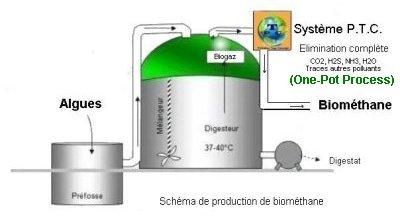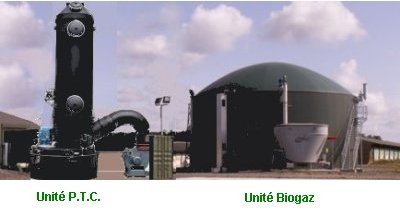P.T.C.
System
and natural hydraulic fracturing
Hydraulic fracturing ?
Initially,
hydraulic fracturing is the technique that releases trapped
gas in Underground rocks to extract gas or oil.
We
also talk about hydrofracturing, hydrosiliceous fracturing,
frac jobs, frac'ing or fracking. These terms relate to hydraulic
fracturing.
Although it has been known by professionals in the petroleum
sector for more than 60 years, this technique is the subject
of recent media coverage.
It is controversial because of the environmental impacts associated
with it in the United States. Hydraulic fracturing is used
every year in tens of thousands of hydrocarbon drilling in
the world.
 Natural terrestrial hydraulic fracturing
Natural terrestrial hydraulic fracturing
Hydrofraction
should not be confused with natural
hydraulic fracturing (cryoclasty) which results,
on the surface, from the effect of the freeze-thaw cycle of
water trapped in a rock and the erosion of land by water to
provide silt, sediment, alluvium and mud in which, the organic
matter accumulates in large quantities and gives a sapropel
(black mud) or lignite (debris of ligneous material).
One finds these accumulations of vase in particular in:
-
The estuaries of rivers.
- The
ports.
- Ponds,
marshes and mudflats (Between 5 and 10% of the world's coastline
consists of mudflats).
- Rivers
and their dead arms.
- Some
hydraulic dams.
- Rivers
and streams.
- Canals.
-
Lakes and lakes.
In
the vases of the ponds there is a high proportion of carbonaceous
organic matter (Up to 78% lignin in the form of complex humus).
Ponds are organic carbon traps.
The sources of this siltation are numerous:
- Decomposition
of plants (aquatic plants, but also surrounding plants-leaves
of trees, etc.),
- Intrinsic
organic effluents (mainly fish and bird droppings),
- Turbidity
of the water due to natural run-off, mineral particle
intake linked to erosion,
- Organic
pollution upstream (livestock, wastewater, etc.)
It
is aggravated by a biological imbalance caused, for
example, by overfishing of fish, chemical eutrophication
and the absence of wetlands around the perimeter.
|
|
|
The
organic matter content
The proportion of organic matter in the dry matter of sediments
varies between 90% in the case of peat and 2% in the case
of river sands.
The composition of this organic matter is generally identical
from one type of sediment to another. In general, the proportion
of organic matter is of the order of 2 to 10% for the sediments
of the courses of "white water" and consists of 60% of humic
compounds (which is related to humus, ie all stable organic
matter in the surface layer of a soil).
These
"muddy" materials which are more or less rich in organic matter
can therefore be subjected Methanisation in the same way as
sludge from sewage treatment plants.
P.T.C. System is involved in the purification of the biogas
obtained to provide the Bio-methane.
The P.T.C.
System and its GASWASH
process are perfectly adapted technically and economically
for the purification of the biogas obtained by the natural
terrestrial hydraulic fracturing.
 Natural marine hydraulic fracturing
Natural marine hydraulic fracturing
Natural
hydraulic fracturing on shorelines is also the action of waves
and tides that periodically deposit seaweed on beaches.
 Brittany, how to get rid of green algae (Ulves)
Brittany, how to get rid of green algae (Ulves)
|
Under
the effect of a tendency to global warming, under the
effect of aqueous discharges of livestock waste and
water runoff along the coastline there are significant
deposits of algae.
Each year, about 70,000 cubic meters of green algae
washed up on the beaches of about fifty municipalities.
T here are two species are difficult to distinguish
armoricana Ulva and Ulva rotundata.
Funded by local authorities, the collection of ulves
costs about 500 k € per year, or 1.5 billion euros in
30 years.
|
|
|
The
ecological association Eau et Rivières de Bretagne estimates
the price at 1 billion euros in thirty years. One thing is
certain, some researchers are working on the use of these
algae to make it compost.
There
are many prevention plans to combat chemical eutrophication
due to intensive farming and N fertilizer application in crops.
However, the plans for direct treatment of algae are very
limited: direct application and composting. (plan_algues_vertes.pdf).
It
should be noted that direct spreading is a transfer of nitrogen
pollution because the nitrogen of the algae returns to the
ground.
 West Indies, how to get rid of seaweed Sargassum (brown algae)
West Indies, how to get rid of seaweed Sargassum (brown algae)
|
In Martinique, Guadeloupe, French Guiana and Saint-Martin,
the sargasses aground in rafts of several hundreds of
square meters of surface and several meters of thickness.
These brown algae colonize since 2011 the Caribbean
Sea, but the phenomenon continues to grow.
These algae also cause enormous damage to the fauna
and flora when they stagnate in the bays by preventing
the sun from entering the water and killing the fish.
The nesting of the turtles is disturbed, the banks of
seaweeds preventing them from coming to lay in the sand.
A project of the County Council of Guadeloupe envisages
the use of a "bottom dredging boat" to "suck on the
high seas" Sargassum, "before they arrive on the coast".
Once harvested, they would be crushed and discarded
on the high seas "by 400 m depth".
|
|
|
According to Franck Robine, the prefect of Martinique, a hundred
people and 35 machines are mobilized for the daily collection.
"It cost 1.6 million euros in March and April 2018," he says.
Martinique municipalities affected have already estimated
more than 1.5 million euros damage and miscellaneous costs.
For local tourism, it is a huge shortfall at the time of the
summer season.
While
it is essential to collect these Sargassum algae, a biogas
upgrading treatment is possible with the purificatuion of
the latter in biomethane thanks to the PTC
system and its GASWASH
process which are perfectly adapted technically and economically.
 The methanisation of Ulvae
The methanisation of Ulvae
Green
algae are rich in organic nitrogen being, which is found in
part, mineralized in its ammoniacal form impacting any spreading
plan put in place for farming.
The
methanization of green algae to produce biogas, bio-methane
and possibly electricity is theoretically possible but never
applied to our knowledge.
|

|
|
To
date, the methanization of algae faces a major problem
with current techniques: The high content of green
algae in sulfur (up to 5% of the dry weight of the
alga, ten times more than ordinary green waste).
This
problem of sulfur is solved with the P.T.C. Which
makes it possible to eliminate considerable levels
of sulfur derivatives at a very competitive cost.
The P.T.C. Is positioned directly at the methanizer
outlet and thus directly supplies the biomethane.
(http://www.innovalor.fr/page2.htm)
|
A methanisation carried out by mixing seaweed and livestock
manure is deemed to function almost correctly ... in Germany.
The
P.T.C.
System and its GASWASH
process are perfectly adapted technically and economically
for the purification of the biogas obtained by the natural
terrestrial hydraulic fracturing.
In
conclusion, the natural hydraulic fracturing sector represents
an unprecedented opportunity for the production of Biogas
which will be purified in Bio-methane with the P.T.C. System.
 Biogas
purification technology with P.T.C. Biogas
purification technology with P.T.C.
|
The
biogas obtained from natural fracturing (Fracking) will
have to be purified for optimal use.
In order to transform biogas into a substitute for natural
gas, it is necessary to get rid of all the pollutants.
The P.T.C. Brings the technical solution that today
allows biogas producers to efficiently use biomethane
with its purification process.
The technology used makes it possible to permanently
eliminate carbon dioxide (recyclable CO2), and to eliminate
in the same operation the sulfur compounds, H2O, NH3,
and others ....
|
|

Example of implementation of the P.T.C. System
on a methanation unit
|
The
hydrogen sector, starting from methanisation, should logically
find a preponderant place in the near future..
This application of the P.T.C. System is patented
|
![]() Valorisation
Valorisation